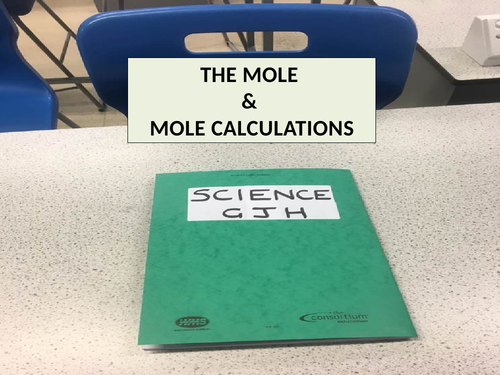


A fully-resourced lesson that looks at the meaning of the mole and shows how this measurement is used in calculations. The lesson includes a clear lesson presentation (32 slides) and a set of questions. This lesson has been written to explain in a concise manner so that the key details are understood and embedded. Students are shown how to recognise when a mole calculation requires them to use Avogadro’s constant and when they should the formula including the relative formula mass.
This lesson has been designed for GCSE students (14 -16 year olds in the UK)
Get this resource as part of a bundle and save up to 36%
A bundle is a package of resources grouped together to teach a particular topic, or a series of lessons, in one place.
Topic C1e: Chemical formulae, equations and calculations (Edexcel iGCSE Chemistry)
This bundle of 10 lessons covers the majority of the content in Topic C1e (Chemical formulae, equations and calculations) of the Edexcel iGCSE Chemistry specification. The topics and specification points covered within these lessons include: * Writing word equations * Writing balanced symbol equations (with state symbols) * Calculate relative formula masses * Know that the mole is the unit for the amount of a substance * Understand how to carry out calculations involving amount, relative atomic and formula mass * Calculate reacting masses * Calculate percentage yield * Know the terms empirical formula and molecular formula and be able to calculate both * Calculate concentration of solutions * Calculate gas volumes All of these lesson presentations and accompanying resources are detailed and engaging and contain regular progress checks to allow the students to constantly assess their understanding.
Topic C4: Stoichiometry (Cambridge iGCSE Science Double Award)
This bundle of 10 lessons covers all of the content in Topic C4 (Stoichiometry) of the core and supplement sections of the Cambridge iGCSE Science Double Award specification. The topics and specific points covered within these lessons include: Use the symbols of the elements and write the formulae of simple compounds Determine the formula of an ionic compounds from the charges on the ions present Construct and use word equations Construct and use symbol equations, with state symbols, including ionic equations Deduce the balanced equation Relative formula mass Define the mole in terms of Avogadro's constant Use the molar gas volume Calculate stoichiometric reacting masses and volumes of gases Calculate the concentration of solution All of these lesson presentations and accompanying resources are detailed and engaging and contain regular progress checks to allow the students to constantly assess their understanding
Topic C3: Quantitative chemistry (AQA GCSE Chemistry)
This bundle of 9 lessons covers all of the content in Topic C3 (Quantitative Chemistry) of the AQA GCSE Chemistry specification. The topics covered within these lessons include: Conservation of mass and balanced symbol equations Relative formula mass Mass changes when a reactant or product is a gas Moles Using moles to balance equations Limiting reactants Concentration of solutions Percentage yield Atom economy Volumes of gases All of these lesson presentations and accompanying resources are detailed and engaging and contain regular progress checks to allow the students to constantly assess their understanding.
Topic C3: Chemical reactions (OCR Gateway A GCSE Combined Science)
This bundle of 18 lessons covers all of the content in Topic C3 (Chemical reactions) of the OCR Gateway A GCSE Combined Science specification. The topics covered within these lessons include: Conservation of mass Writing word and symbol equations Writing ionic equations The mole Mole calculations Calculating masses Concentrations Endothermic and exothermic reactions Bond energy calculations Making salts Reactions of acids Oxidation and reduction reactions Electrolysis Writing half equations for electrolysis Detecting gases All of these lesson presentations and accompanying resources are detailed and engaging and contain regular progress checks to allow the students to constantly assess their understanding.
Calculations involving masses (Edexcel GCSE Combined Science & Chemistry)
This bundle of 7 lessons covers the majority of the content in the C1 sub-topic called CALCULATIONS INVOLVING MASSES of the Edexcel GCSE Combined Science & GCSE Chemistry specifications. The topics covered within these lessons include: Calculating relative formula mass Empirical formula The law of the conservation of mass Calculating masses in reactions Calculating concentration of solutions Avogadro's constant Mole calculations Limiting reactants Stoichiometry All of these lesson presentations and accompanying resources are detailed and engaging and contain regular progress checks to allow the students to constantly assess their understanding.
Topic C3.1: Introducing chemical reaction (OCR Gateway A GCSE Combined Science & Chemistry)
This bundle of 9 lessons covers the majority of the content in the sub-topic C3.1 (Introducing chemical reactions) of the OCR Gateway A GCSE Combined Science and GCSE Chemistry specification. The topics covered within these lessons include: Formulae of ionic compounds Conservation of mass Writing chemical equations Writing ionic equations The mole Mole calculations All of these lesson presentations and accompanying resources are detailed and engaging and contain regular progress checks to allow the students to constantly assess their understanding.
Topic C3: Quantitative Chemistry (AQA Trilogy GCSE Combined Science)
This bundle of 5 lessons covers the majority of the content in Topic C3 (Quantitative Chemistry) of the AQA Trilogy GCSE Combined Science specification. The topics covered within these lessons include: Relative formula mass The mole Conservation of mass The mole and equations Limiting reactants Concentration of solutions All of these lesson presentations and accompanying resources are detailed and engaging and contain regular progress checks to allow the students to constantly assess their understanding.
Something went wrong, please try again later.
Great, simple and easy to follow.
Thanks for sharing. It saved me some time in prep.
Brilliant resource, really clear and helpful, thank you!
A well sequenced lesson that allowed me to easily and effectively explain the mole calculations to my students.
Report this resourceto let us know if it violates our terms and conditions.
Our customer service team will review your report and will be in touch.